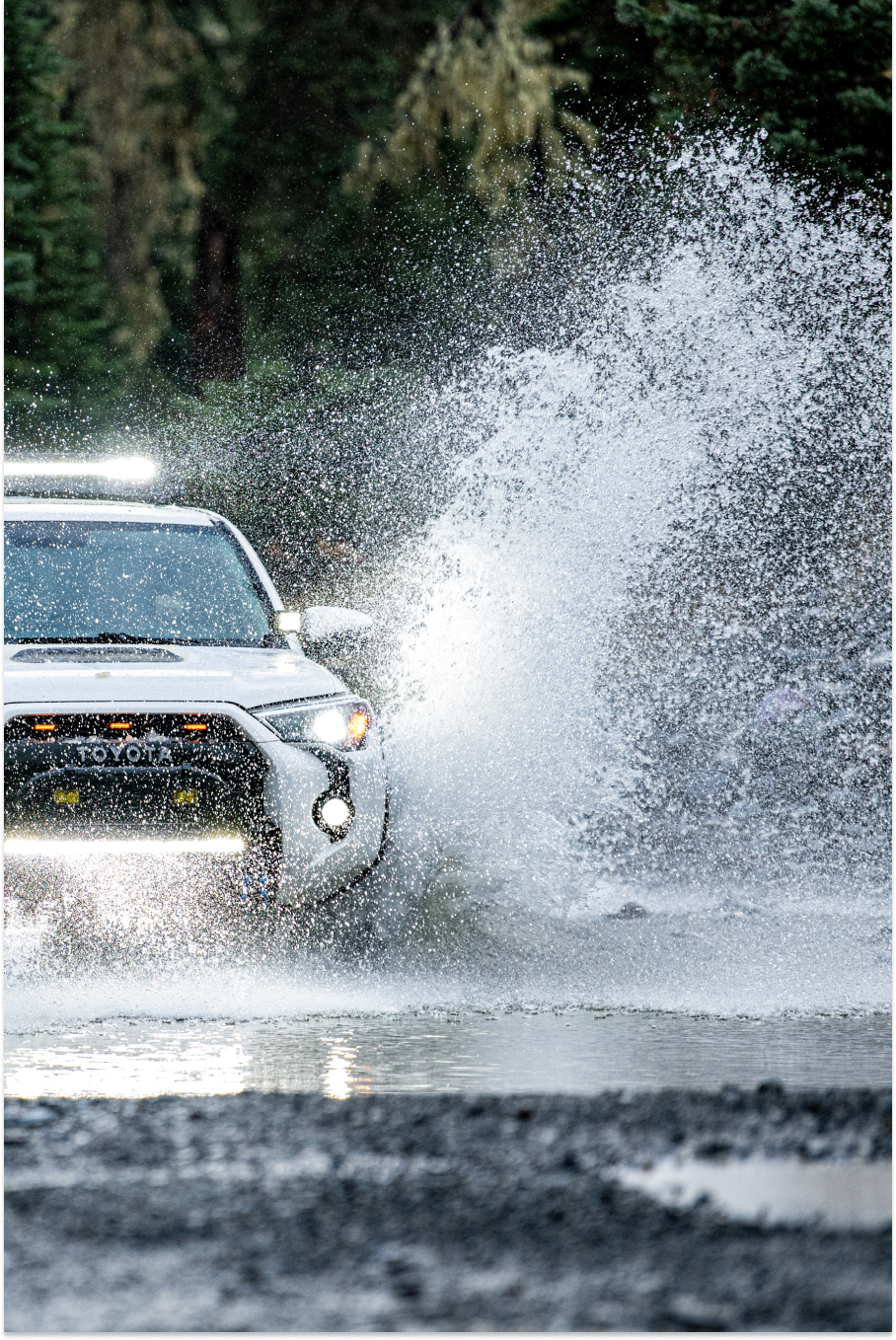The Best 4Runner Roof Rack for Your 5th Gen Toyota
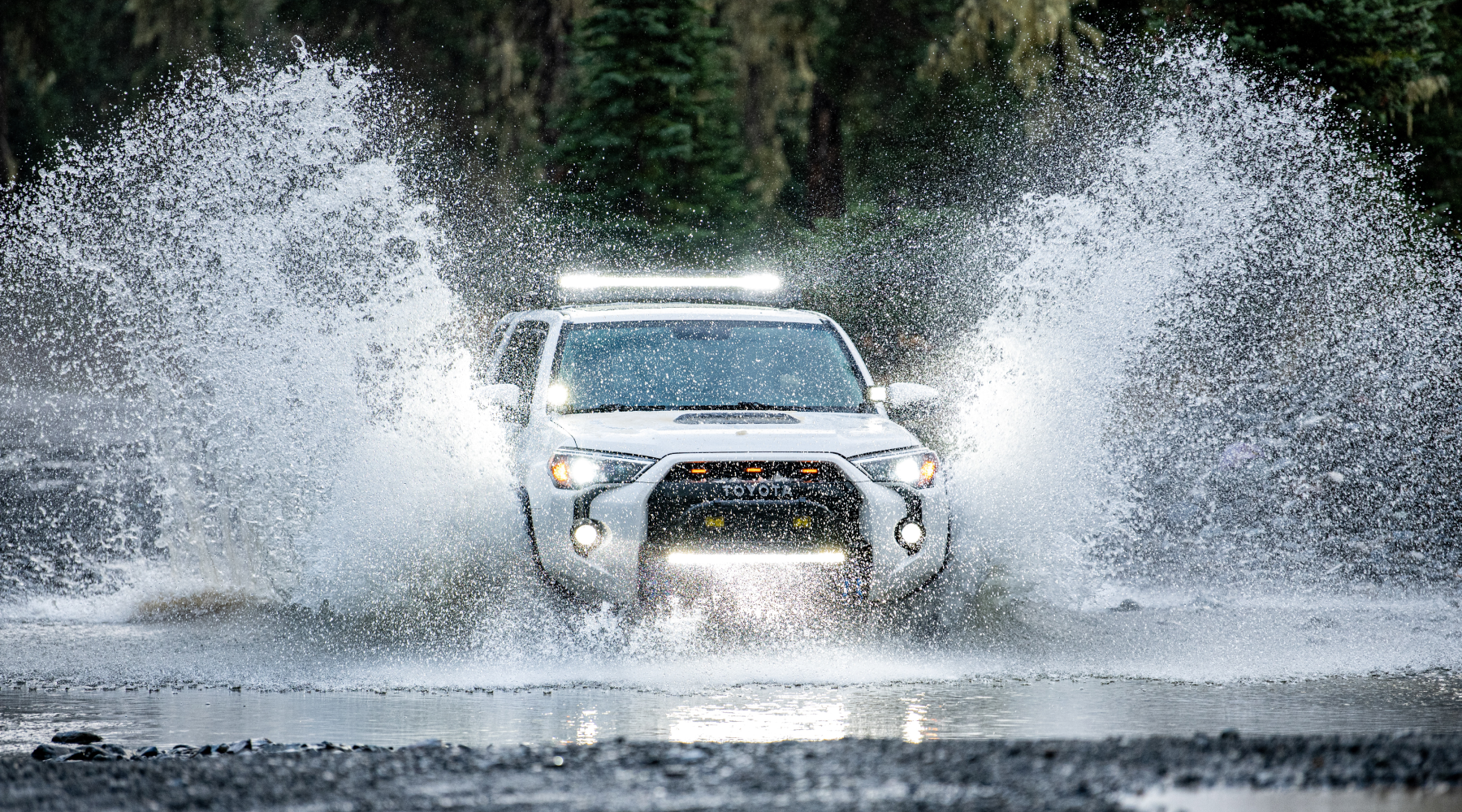
Are you looking to enhance your 5th Gen Toyota 4Runner with the perfect roof rack? Whether you’re an off-roading enthusiast, a family road trip planner, or simply someone who needs extra storage for daily use, a Toyota 4Runner roof rack can provide the versatility and practicality you require. In this comprehensive guide, we’ll explore various factors to consider, when deciding on the top 4Runner roof rack options available, the customization possibilities, and real-life experiences from 4Runner owners. Get ready to elevate your 4Runner’s capabilities and make the most of your adventures.
Key Takeaways
-
This guide provides an in-depth look into the key factors to consider for your 5th Gen 4Runner.
-
Assess individual needs and preferences, research compatibility with factory mounts, explore the best options including full-length, 3/4 & basket style racks.
-
Customization options including lighting, storage accessories & off-road essentials.
-
Installation tips & tricks for secure fitment and ongoing maintenance once the rack is installed.
Choosing the Perfect Roof Rack for Your 4Runner

To choose the best rack for your 5th Gen 4Runner:
-
Assess your specific needs and uses
-
Understand the different available rack materials and the pro's and con's of each
-
Confirm potential rack's compatibility with your vehicle’s load rating, and factory mounts
-
Review the top options available in the market, including full-length, 3/4, and basket-style racks.
In the following subsections, we’ll dive deeper into these different factors to help you make an informed decision and find the perfect rack.
Assessing Your Needs
The evaluation of your specific requirements is a key step when choosing a roof rack. This includes considering:
-
The type of items you will be transporting, such as storage boxes, gun cases, recovery gear, bicycles, kayaks, snowboards, skis, camping gear, and more.
-
Do you want a basic rack, or something with additional features like the Gobi Rack, which comes with a ladder, and wind deflector to minimize wind noise while driving.
Given the diverse range of equipment and gear that can be transported on a roof rack, understanding your needs is a crucial first step. By carefully assessing your needs, you’ll be better equipped to choose a roof rack tailored to your requirements, ensuring a seamless and enjoyable off-roading or road trip experience.
Dynamic and Static Loads: Unpacking the Basics
Before delving into the nitty-gritty of selecting a roof rack for your Toyota 4Runner, it's essential to grasp the concept of dynamic and static loads. These terms hold the key to ensuring your roof rack can withstand the trials of off-roading and any loads that you put on them.
Static Load: This refers to the weight of your cargo when it's at rest or in a stationary position. For instance, if you're transporting camping equipment, bicycles, or a kayak, the static load represents the combined weight of these items when they are securely fastened to your roof rack.
Dynamic Load: On the other hand, dynamic load is the force experienced by your roof rack when your vehicle is in motion. This force includes factors like wind resistance, sudden braking, acceleration, and the impact of rough terrain while off-roading. Dynamic loads are more strenuous on the roof rack and the vehicle itself.
The Weight of the Rack and Its Impact on Load Capacity
Now, let's explore how the weight of the roof rack itself affects its load capacity. It might seem counterintuitive, but the weight of the rack is a crucial consideration when determining how much you can safely carry.
The weight of the rack contributes to the overall dynamic load. The heavier the rack, the more stress it places on your vehicle's suspension and structure. Therefore, it's important to factor in the weight of the roof rack when calculating the total dynamic load. Exceeding your vehicle's dynamic load capacity can lead to safety issues and vehicle damage. Be sure to check your vehicles manual to verify the load capacity then add the total weight of the accessories and the rack to make sure your vehicle and rack combination is under your load capacity.
Material Choices: Aluminum vs. Steel
The choice of material plays a vital role when it comes to roof racks, particularly as it relates to load capacity. The two primary materials used in the construction of roof racks are aluminum and steel, each with its own set of advantages and disadvantages.
Aluminum is known for being light weight, durable, and cost-efficient and is used by many manufacturers. However, despite its many benefits, aluminum is softer than steel and may not be as resilient as steel to impacts, heavy loading and corrosion in salty environments, although this is typically mitigated by anodizing or powder coating the components. In addition it will not rust, so you won't end up with rust streaks on your vehicle should moisture breach the powder coat.
Steel is renowned for its strength and longevity, and is capable of withstanding extreme weather conditions. However, steel is heavier than aluminum; impacting the amount of accessory weight load available and your vehicles available dynamic load. In addition it is corrosive and will rust if the powder coating is damaged, creating risk for rust stains on your vehicle.
Compatibility with Factory Rails and Mounts

Ensuring that your chosen roof rack is compatible with your 4Runner’s factory rails and mounting points, and verifying you receive all the correct components, is crucial for a secure and proper fit. Most aftermarket roof racks require removal of the factory side rails first, and utilize the existing factory mounting locations to mount the new side rails as shown in the image above. To prevent potential installation issues, it’s important to confirm whether the roof rack you select is compatible with your 4Runner’s factory rails or accessory mounts. Some models, such as the UpTop Bravo 5G roof rack and Prinsu Design Studio's, Prinsu Roof Rack, are designed to work seamlessly with factory mounting systems and most racks will specify that there is no drilling required. Others like the Westcott Designs full-length lo-pro roof rack may require new factory OEM bolts to be compatible when using the factory mounts. Regardless of the rack, thorough compatibility research ad confirmation are critical to a smooth installation process and optimal roof rack performance.
Top Roof Rack Options for 5th Gen 4Runners
Now that you’re familiar with the factors to consider when choosing a roof rack, let’s explore some of the best roof rack options available for 5th Gen 4Runners. We’ve compiled a comprehensive list of full-length, 3/4, and basket-style racks to suit various needs and preferences.
In the following subsections, we’ll delve into each type of roof rack, discussing their features, benefits, and potential drawbacks. Whether you’re seeking a full-length rack for maximum storage capacity, a 3/4 rack that offers a balance between storage and a compact design, or a versatile basket-style rack, there’s an option available to cater to your specific requirements. A thorough exploration of these top roof rack options will enable you to make an informed decision and boost your 5th Gen 4Runner’s capabilities.
Full-Length Roof Racks
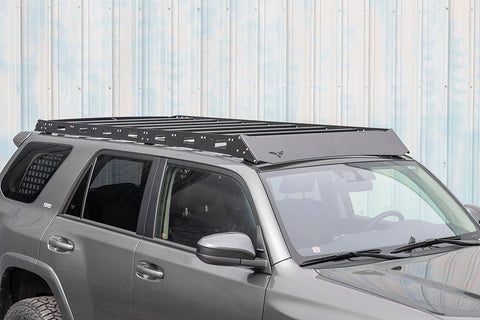
Full-length roof racks, and full roof rack systems, provide maximum storage space for extra gear and versatility for a wide range of off-road and travel needs. Considering the features and benefits of various full-length roof racks can guide you to select the optimal solution that will enhance your off-road adventures. When evaluating full length roof racks consider the following:
-
Are they designed to minimize wind noise while driving?
-
Do they support LED light bars like Baja Designs, KC Lights, or Cali Raised LED?
-
Are they suitable for off-roading excursions and have substantial load ratings?
-
Do they offer customization options like adjustable cross bars, a light bar cut out, or ladders?
-
Do they support various accessory mounting options, like fuel canisters, rooftop tents, kayak racks, or shovel mounts?
3/4 Roof Racks
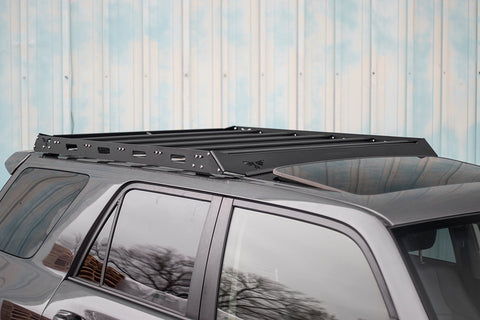
3/4 roof racks offer a balance between storage capacity and a compact design, making them suitable for those with moderate storage needs. Some popular 3/4 roof racks include the Sherpa Needle, and the Toyota 4Runner Prinsu Roof Rack 3/4, both of which are very-low profile, feature adjustable crossbars, and are made in America.
Top Full-Length and 3/4 Length Roof Rack Manufacturers:
Basket-Style
Basket-style roof racks are an affordable and easy-to-install option for additional storage and gear transportation. Most basket style are compatible with factory roof rails, or aftermarket cross bars like the Rhino-Rack Vortex. For example, the Yakima MegaWarrior Cargo Basket is a versatile option, featuring an integrated wind deflector to minimize wind resistance.
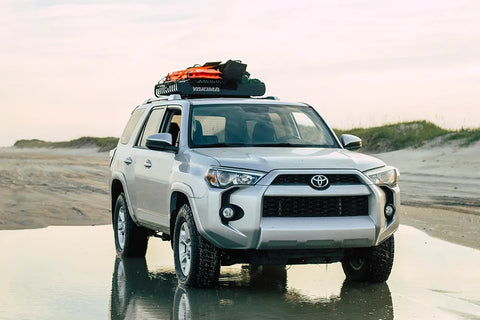
Platform Style Roof Racks
Another option is a platform Style roof rack, which mimics a custom rack, but can normally be mounted on cross bars like Rhino-Rack, Thule, or Yakima. Some popular platform-style roof racks include the Front Runner Slimline II and ARB Base Rack, both offering a variety of accessories suit your needs.

Top Basket and Platform Roof Rack Manufacturers:
Customizing Your Roof Rack: Accessories and Add-Ons
A roof rack is more than just a storage solution; it’s an opportunity to customize your 4Runner to meet your specific needs and preferences. With a variety of accessories and add-ons available, you can transform your roof rack into a versatile and practical addition to your vehicle.
Lighting Solutions

Enhancing your roof rack with customized lighting options can significantly improve visibility and safety during off-road adventures. There are various lighting solutions available for different roof racks, such as a dual-function single row front LED light bar, dual row spot beam LED lights, scene lights, and auxiliary lighting setups.
To fit front facing lights most racks feature a light-bar cutout to keep a low profile design for improved fuel economy and appearance. Incorporating customized lighting options, into your roof rack setup can enhance both the aesthetics of your 4Runner and the safety and functionality during your off-road adventures.
Storage Accessories
Maximizing your roof rack’s storage capabilities can be achieved with various accessories, such as cargo baskets, bike racks, fuel can holders, ski racks, kayak mounts, and awning mounts. These storage accessories not only provide additional space for your gear but also help keep your items organized and easily accessible during your travels.
Other accessories like a rooftop tent allows you to set up camp with ease and comfort, providing a secure and elevated sleeping space during your off-road excursions. Incorporating off-road essentials into your roof rack setup prepares you well for any adventure that comes your way.
Off-Road Essentials
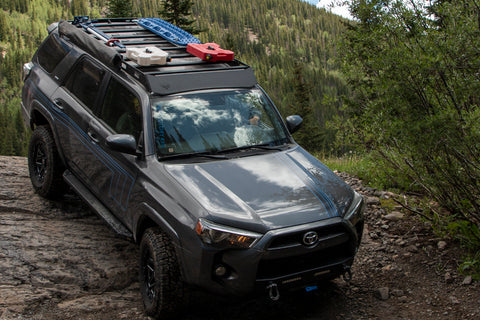
Equipping your roof rack with off-road essentials like spare tire mounts, traction boards, recovery gear storage, and rooftop tents can significantly enhance your off-roading experience. These essentials not only provide added convenience and functionality but also ensure that you’re prepared for any situation that may arise during your adventures.
Installation Tips and Tricks
Installing a roof rack on your 5th Gen 4Runner may seem like a daunting task, but with the right guidance and some helpful tips and tricks, you can ensure a secure and proper fit. In the following subsections, we’ll cover the essential steps for preparing your 4Runner, assembling and mounting your chosen roof rack, and performing post-installation checks and maintenance.
Following these installation tips and tricks equips you to have your rack installed with confidence and ease, resulting in a secure and reliable roof rack setup for all your off-road and road trip adventures.
Preparing Your 4Runner
Before proceeding with the installation process, you should prepare your Toyota 4Runner by cleaning and inspecting the factory rails and mounting points. This may involve removing any existing equipment such as the factory roof rack. Additionally, it’s important to ensure that all necessary components for your chosen roof rack are present and in good condition.
Once your 4Runner is prepared, you can begin the full rack installation process by following the manufacturer’s specific instructions for your roof rack model. This will help ensure a secure and proper fit, providing a solid foundation for your off-road and road trip adventures.
Assembling and Mounting the Roof Rack
When assembling and mounting your roof rack, it’s important to follow a step-by-step process to ensure a secure and proper fit. Of course this will depend on the rack you purchase but in general, begin by organizing the rack parts and identifying the initial crossbars based on the mounting points on your vehicle’s roof. Then, attach the new side rails to the mounting points using the supplied mounting hardware.
Next, attach the mounting brackets to the ends of the roof rack and lift the rack into position at the rear of the vehicle. Carefully slide the roof rack forward until it’s in the correct location, making sure the mounting brackets are securely tightened once everything is correctly positioned.
Following these steps ensures that your roof rack fits securely and properly, providing a reliable foundation for your off-road and road trip adventures.
Post-Installation Check and Maintenance
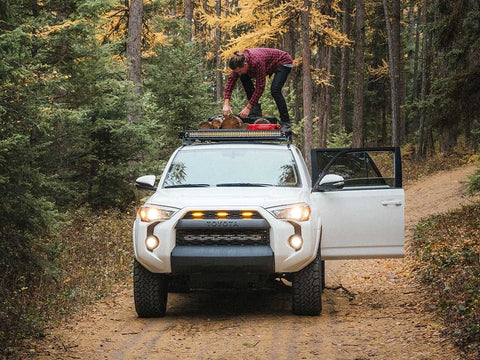
After installing your roof rack, it’s essential to perform post-installation checks and routine maintenance to keep it in optimal condition. By following these steps, you can ensure that your roof rack remains in good condition and safe to use. Here are some steps to follow:
-
Inspect the roof rack for any signs of damage or wear.
-
Ensure that all bolts and brackets are securely tightened, add lock-tight as instructed.
-
Check the load capacity of your roof rack and ensure it’s not overloaded.
Regularly clean your roof rack to remove dirt and debris, and inspect it for rust or corrosion, treating corrosion spots as necessary. If your roof rack has moving parts, such as hinges or locks, lubricate them to ensure optimal functioning. Regular checks and maintenance prolong the life of your high quality rack, ensuring a reliable and secure roof rack setup for your adventures.
Summary
In conclusion, choosing the perfect roof rack for your 5th Gen Toyota 4Runner involves assessing your specific needs, understanding the available materials, ensuring compatibility, and exploring top options in the market. By customizing your roof rack with accessories and add-ons, you can significantly enhance its functionality, versatility, and aesthetics, creating the ultimate setup for your off-road and road trip adventures.
With the right roof rack, your 5th Gen 4Runner can truly become an extension of your lifestyle, allowing you to tackle off-road adventures, family road trips, and everyday errands with ease and confidence. So, go ahead and find the perfect roof rack for your own 4Runner 5th gen, and start creating unforgettable memories on the road less traveled.
Frequently Asked Questions
Can you add a roof rack to a 4runner?
You can add most aftermarket roof racks to a 4Runner. Aftermarket racks will provide additional space for items such as fuel cans, MAXTRAX , RotopaX, storage boxes, and more.
Are roof racks worth it, 4runner?
A roof rack is worth the investment for 4runner owners who need to transport gear, kayaks, canoes, a rooftop tent, and other materials. Whether you're a weekend warrior or an everyday worker, it offers more space to tie down your load.
How do you put crossbars on a 4runner?
To put crossbars on a 5th gen 4Runner, use a plastic pry bar to snap the rear cover of rails up and towards the center of the vehicle. There are 4 plastic snaps that will release. Once the cap is removed, the original equipment manufacturer (OEM) rails will be visible and ready for crossbar installation. Once the front crossbars and bars are in place, tighten them with a 4mm hex key.
How much weight can a 4runner carry on roof?
The Toyota 4Runner's roof rack has a driving load capacity of 300 lbs and a static load capacity of up to 600 lbs. This makes it ideal for camping and other off-road activities.
What factors should I consider when choosing a roof rack for my 5th Gen 4Runner?
When choosing a roof rack for your 5th Gen 4Runner, take into account your desired storage capacity, whether you prefer aluminum or steel, the compatibility of the rack with factory rails and mounts, as well as the available features of each rack.




